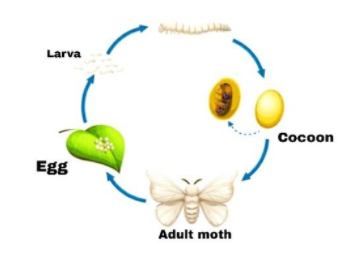
What is sericulture? Explain the life-cycle of silk worms.
Answer
495k+ views
Hint: Sericulture or silk farming consists of cultivating silkworms to produce silk. Although there are several commercial species of silkworms, the Bombyx mori is the most widely used and most studied silkworm. Silk is believed to have been produced in China as early as the Neolithic. In countries such as Brazil, China, France, India, Italy, Japan, Korea and Russia, sericulture has become an important cottage industry.
Complete answer:
Sericulture is the process of growing silkworms and extracting silk from them. Silkworm caterpillars (also known as “Bombyx mori”) are the most commonly used silkworm species in sericulture. Other types of silkworms (such as Eri, Muga and Tasar) have also been bred for the production of “wild silk”. Sericulture is a very important national industry in many countries. India and China are the main silk producers in the world.
For mulberry silk production, the sericulture process follows three main steps:
Moriculture: Mulberry leaf cultivation.
Silkworm rearing: promoting growth of silkworms.
Silk reeling: extract silk from silkworm cocoons.
Life cycle of silk worm:

When the female lays eggs, the life cycle of the silkworm moth begins. Caterpillars or larvae hatch from silk moth eggs. Silkworms feed on mulberry leaves and pupate. In the pupal stage, a weave is netted around by the silkworm to hold and support itself. After that, the silkworm swings its head, which spins a fiber made of a protein and becomes a silk fibre. Several caterpillars form a protective layer around the pupae, and this covering is called a cocoon. Silk thread (yarn) is obtained from the cocoons of silkworm moths.
Note:
Silkworms feed on mulberry leaves and, after the fourth molt, climb up the branches near them and spin their silk cocoons. Silk is a continuous filament containing silk fibroin, secreted by the two salivary glands in the head of each worm, and a gum called sericin that binds the silk together. The sericin is removed by putting the cocoon in hot water, thus loosening the silk threads and preparing them for winding. This is called the degumming process.
Complete answer:
Sericulture is the process of growing silkworms and extracting silk from them. Silkworm caterpillars (also known as “Bombyx mori”) are the most commonly used silkworm species in sericulture. Other types of silkworms (such as Eri, Muga and Tasar) have also been bred for the production of “wild silk”. Sericulture is a very important national industry in many countries. India and China are the main silk producers in the world.
For mulberry silk production, the sericulture process follows three main steps:
Moriculture: Mulberry leaf cultivation.
Silkworm rearing: promoting growth of silkworms.
Silk reeling: extract silk from silkworm cocoons.
Life cycle of silk worm:

When the female lays eggs, the life cycle of the silkworm moth begins. Caterpillars or larvae hatch from silk moth eggs. Silkworms feed on mulberry leaves and pupate. In the pupal stage, a weave is netted around by the silkworm to hold and support itself. After that, the silkworm swings its head, which spins a fiber made of a protein and becomes a silk fibre. Several caterpillars form a protective layer around the pupae, and this covering is called a cocoon. Silk thread (yarn) is obtained from the cocoons of silkworm moths.
Note:
Silkworms feed on mulberry leaves and, after the fourth molt, climb up the branches near them and spin their silk cocoons. Silk is a continuous filament containing silk fibroin, secreted by the two salivary glands in the head of each worm, and a gum called sericin that binds the silk together. The sericin is removed by putting the cocoon in hot water, thus loosening the silk threads and preparing them for winding. This is called the degumming process.
Recently Updated Pages
The number of solutions in x in 02pi for which sqrt class 12 maths CBSE

Write any two methods of preparation of phenol Give class 12 chemistry CBSE

Differentiate between action potential and resting class 12 biology CBSE

Two plane mirrors arranged at right angles to each class 12 physics CBSE

Which of the following molecules is are chiral A I class 12 chemistry CBSE

Name different types of neurons and give one function class 12 biology CBSE

Trending doubts
Which are the Top 10 Largest Countries of the World?

What are the major means of transport Explain each class 12 social science CBSE

Draw a labelled sketch of the human eye class 12 physics CBSE

Differentiate between insitu conservation and exsitu class 12 biology CBSE

The computer jargonwwww stands for Aworld wide web class 12 physics CBSE

State the principle of an ac generator and explain class 12 physics CBSE




